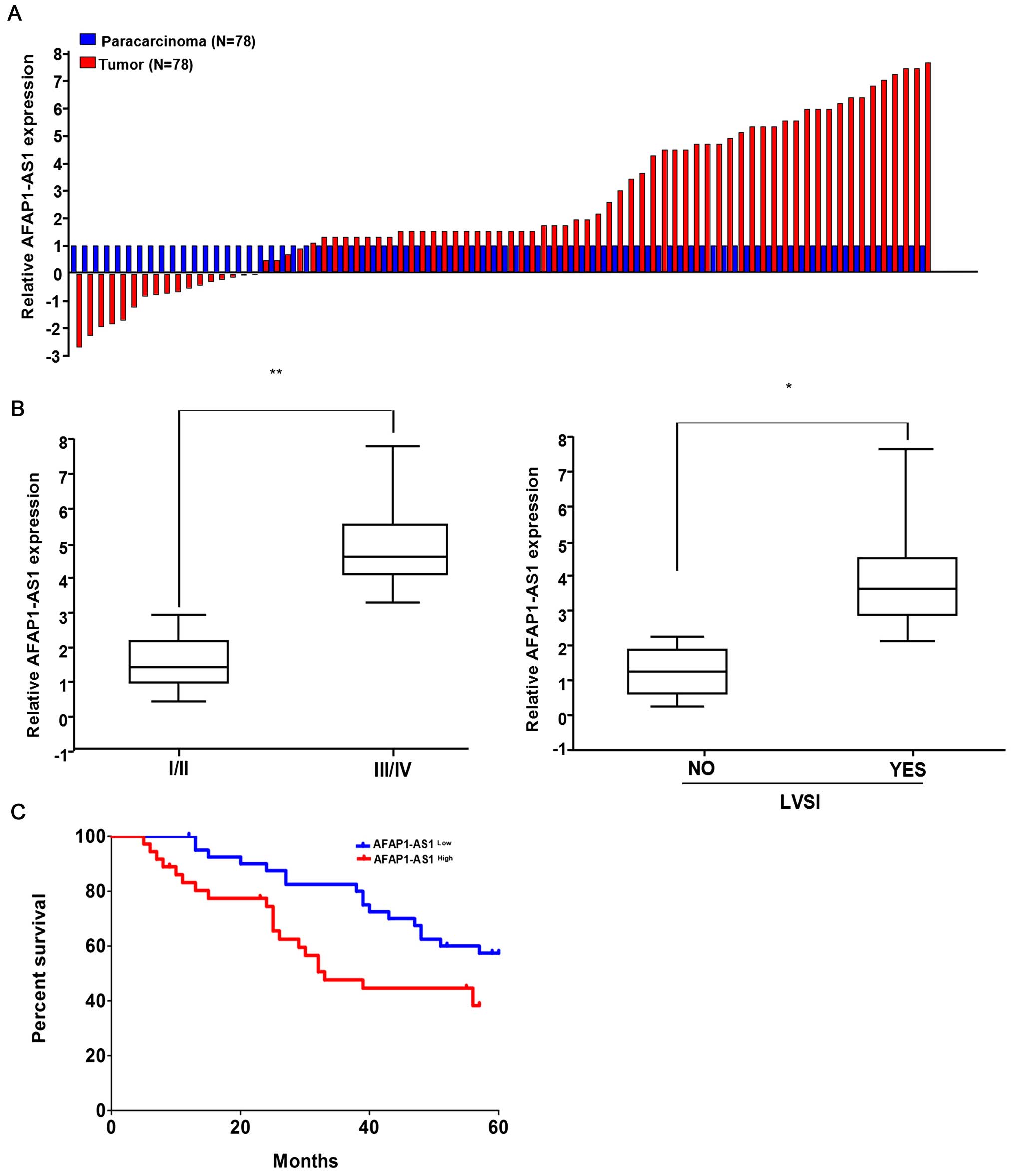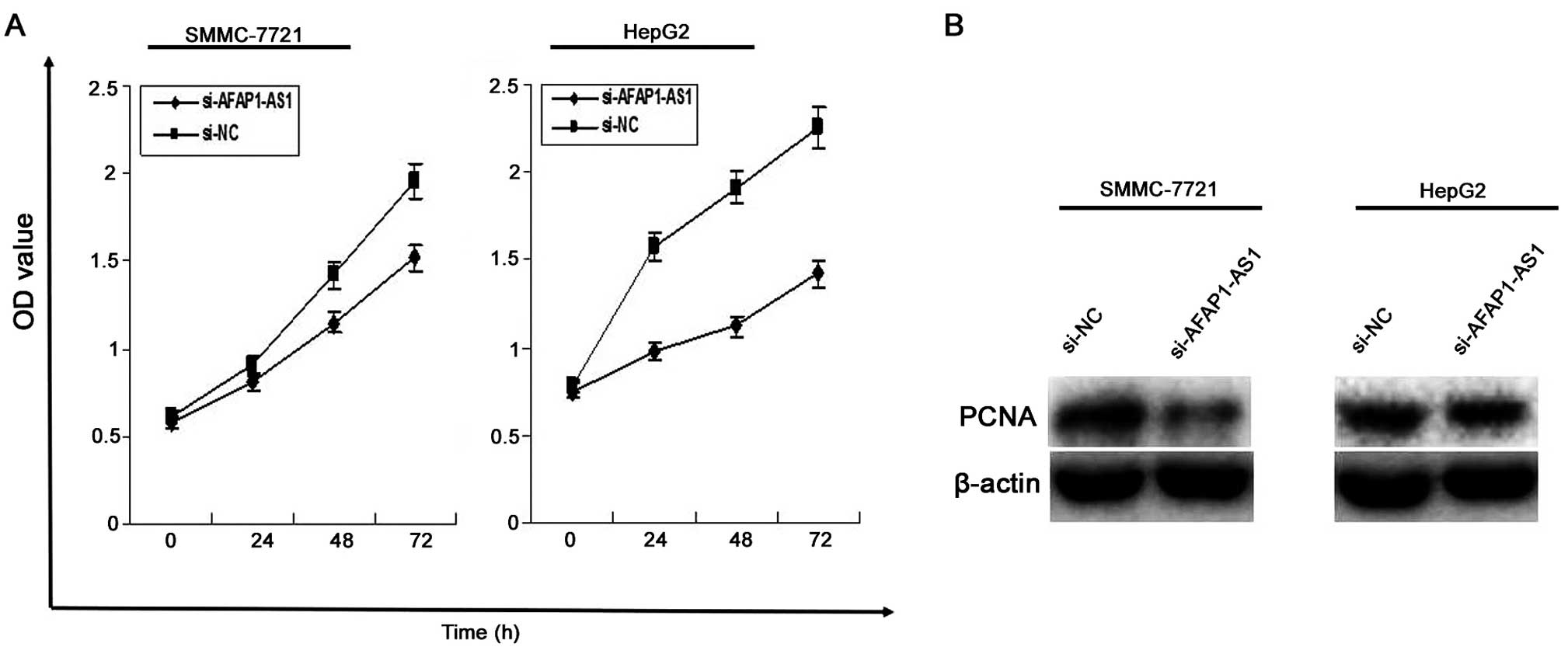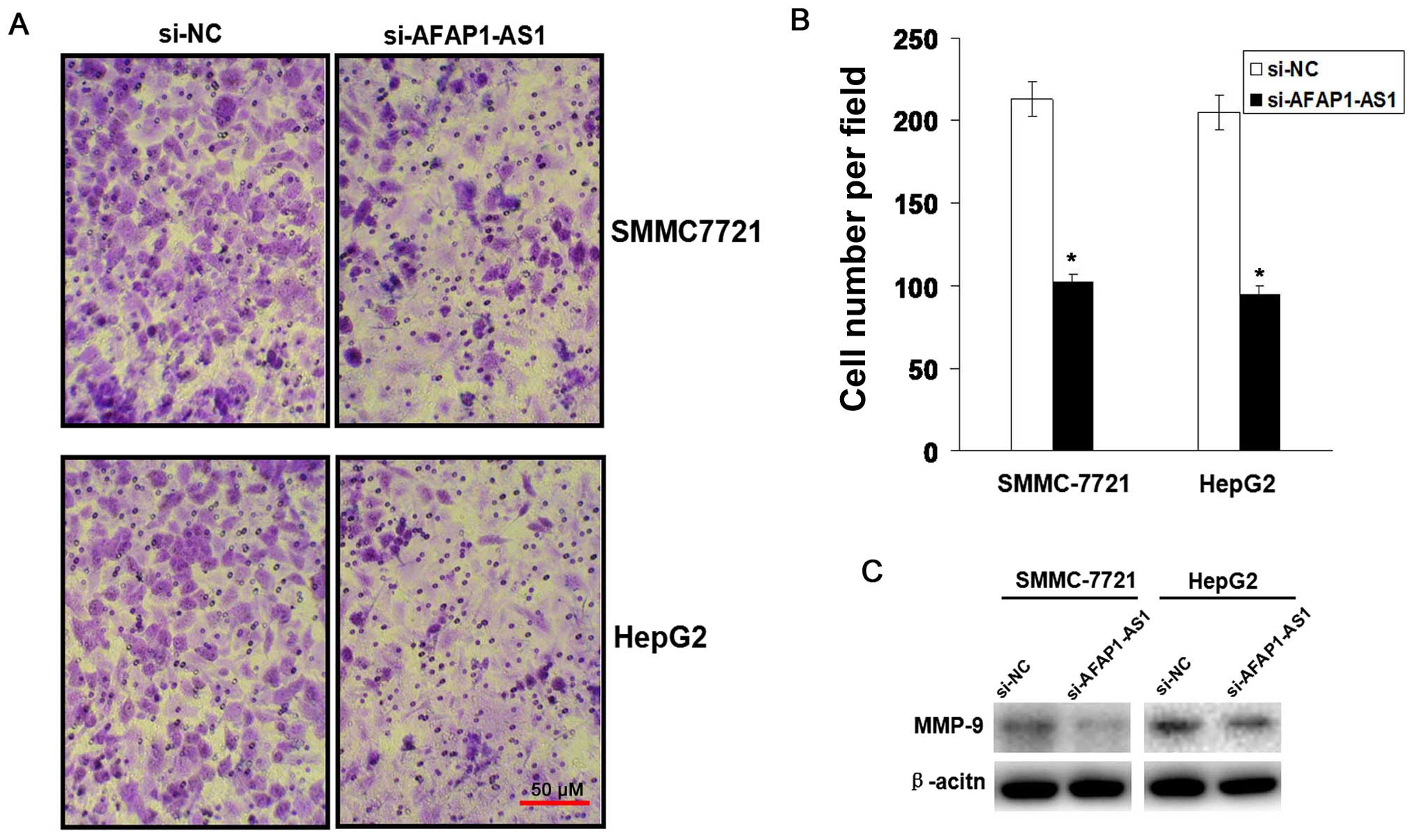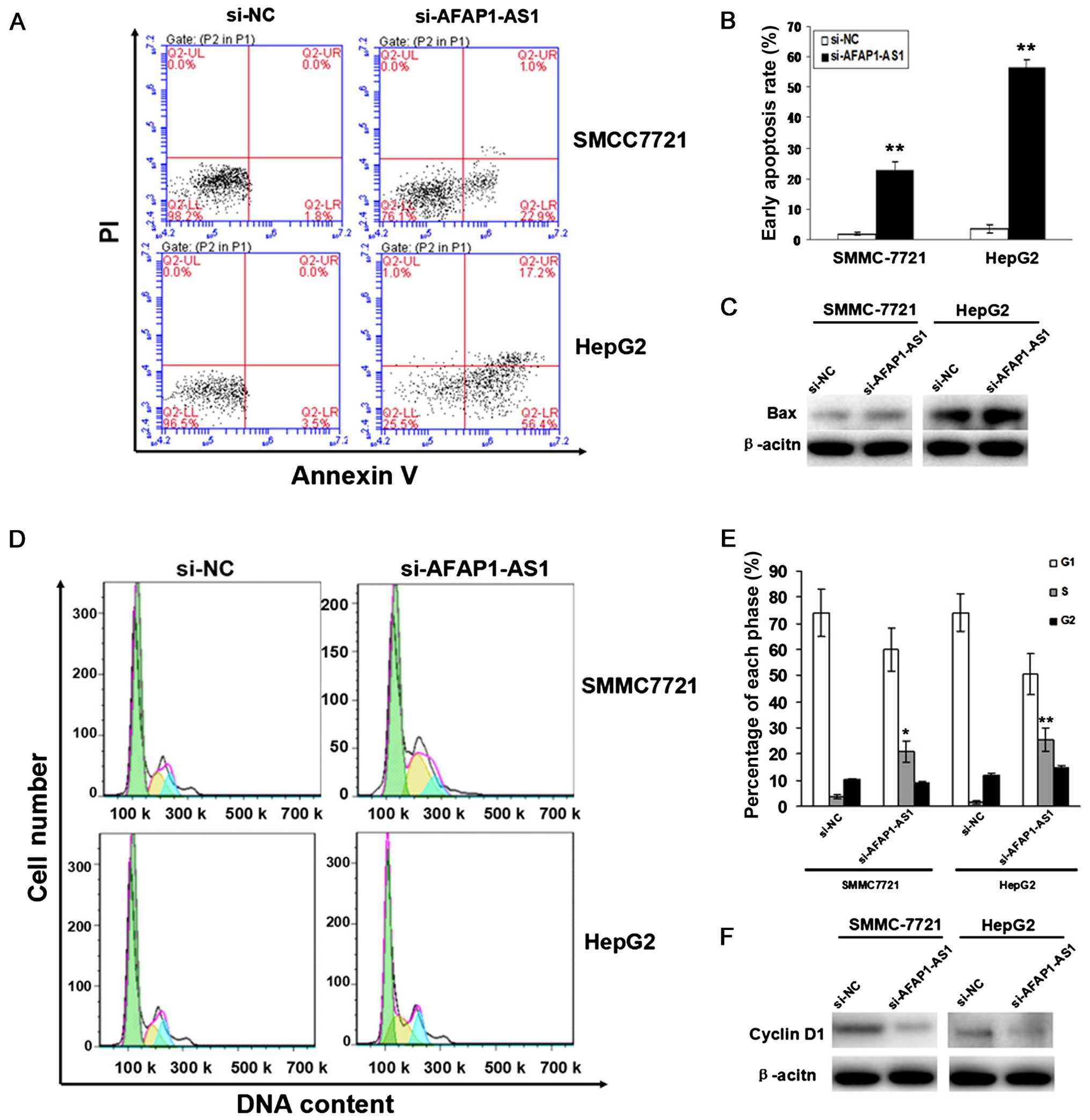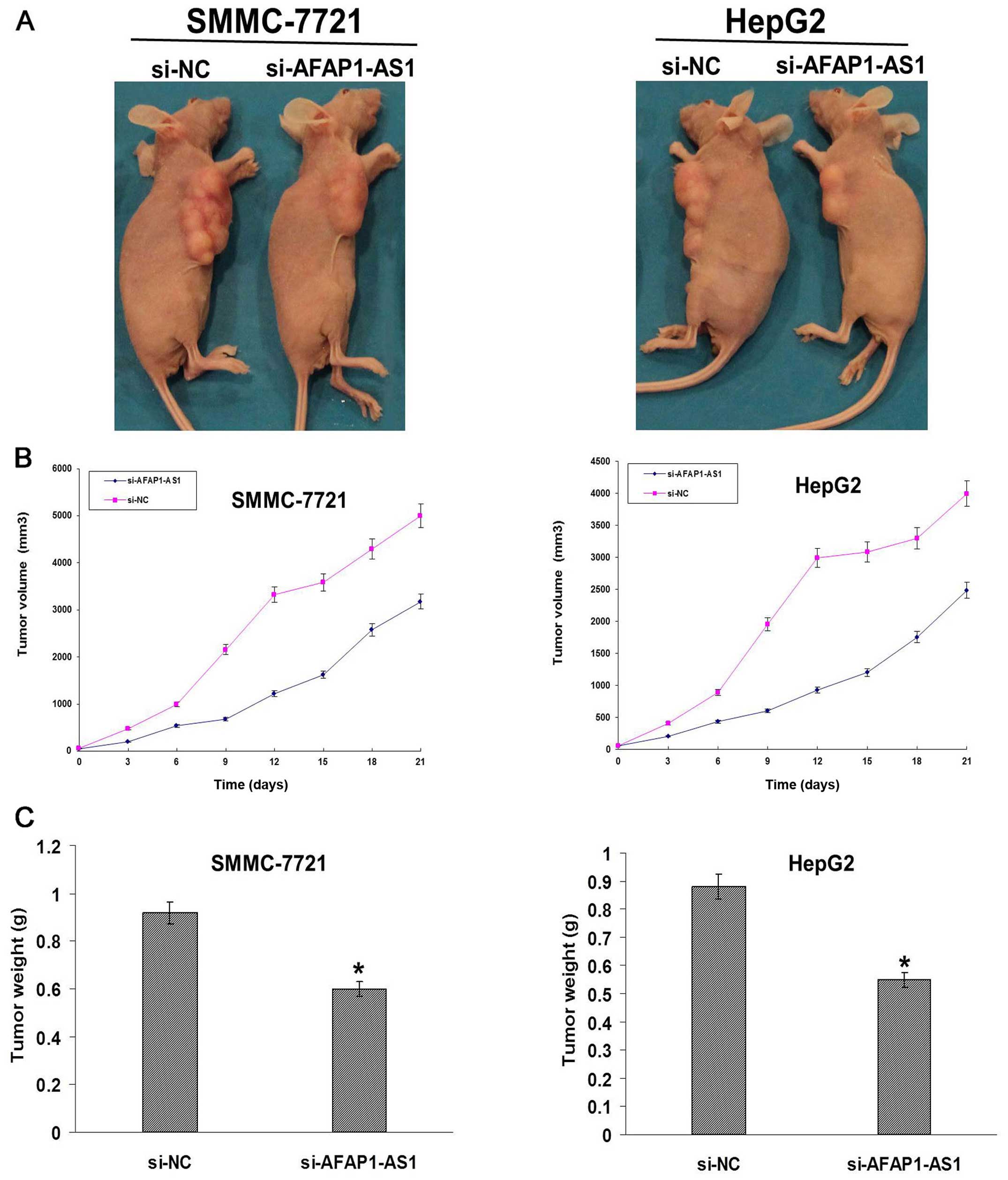Long noncoding RNA AFAP1-AS1 indicates a poor prognosis of hepatocellular carcinoma and promotes cell proliferation and invasion via upregulation of the RhoA/Rac2 signaling
- Authors:
- Published online on: February 8, 2016 https://doi.org/10.3892/ijo.2016.3385
- Pages: 1590-1598
Abstract
Introduction
Hepatocellular carcinoma (HCC) occurs mostly on the basis of pre-existing chronic liver disease and cirrhosis (1) and is a major health issue worldwide as the sixth most common cancer and second leading etiology of cancer-related deaths due to its poor prognosis associated with high recurrence rate and limited treatment options (2–4). Further investigations show that HCC is a genetic disease developing from a multi-step process. Gene aberrance linked to growth control, invasion and metastasis is frequent and provides molecular genetic basis of malignant transformation and tumor progression (5,6). Therefore, to find key genes related to tumorigenesis is of great importance for the diagnosis, targeted therapy, disease monitoring and clinical outcomes in HCC patients.
Long noncoding RNAs (lncRNAs) have no open reading frame and map to intronic and intergenic regions involved in regulating several biological processes such as transcription, translation, cellular differentiation, cell cycle regulation, and chromatin modification (7–9). lncRNAs (1772) have been found differentially expressed between HCC tissues and normal liver tissues (10), of which lncRNA GAS5 is downregulated in HCC indicating an independent prognostic factor for HCC patients (11), and lncRNA MEG3 functions as a growth suppressor via activation of p53 protein (12,13). Inhibition of cellular lncRNA-DREH by Hepatitis B virus X protein (HBx) promotes HCC cell proliferation in vivo and in vivo (14). In addition, overexpression of lncRNA HOTAIR and MALAT-1 may be candidate biomarkers for predicting tumor recurrence in HCC patients (15,16). Enforced expression of lncRNA HEIH facilitates HCC growth through enhancer of zeste homolog 2 (EZH2) (17) and lncRNA MVIH promotes tumor-inducing angiogenesis through inhibiting the secretion of phosphoglycerate kinase 1 (PGK1) (18). In HBV-related HCC, lncRNA HULC decreases p18 expression and boosts growth (19). Hence, lncRNAs play an important role in hepatocarcinogenesis, invasion, and metastasis.
Moreover, investigations have revealed that lncRNA AFAP1-AS1 has been implicated in tumorigenesis of various cancers. Increased expression of AFAP1-AS1 is found in Barrett esophagus, esophageal adenocarcinoma (20) and pancreatic ductal adenocarcinoma (21). Upregulation of AFAP1-AS1 promotes cell invasion and metastasis via regulation of the actin filament integrity, suggesting a poor prognosis and survival for nasopharyngeal carcinoma (22) and lung cancer (23).
However, to our knowledge, few studies have been reported regarding the expression and functions of AFAP1-AS1 in HCC. In the present study, we showed that AFAP1-AS1 was remarkably increased in HCC tissues compared with the adjacent non-tumor tissues and served as an independent predictor for overall survival in HCC. In addition, knockdown of AFAP1-AS1 by si-AFAP1-AS1 inhibited cell growth in vitro and in vivo and cell invasion and induced cell apoptosis and cycle arrest in S phase, associated with regulating the transduction of the RhoA/Rac2 signaling, indicating that AFAP1-AS1 plays a critical role in the progression of HCC.
Materials and methods
Materials
Human HCC cell lines (SMCC7721 and HepG2) were from Institute of Biochemistry and Cell Biology (Shanghai, China). Lentivirus-mediated si-AFAP1-AS1 was purchased from Genechem Biotech Co., Ltd. (Shanghai, China). All antibodies including RhoA, Rac2, PCNA, MMP-9, CyclinD1 and Bax were from Santa Cruz Biotechnology (Santa Cruz, CA, USA).
Drugs and reagents
Dulbecco's modified Eagle's medium (DMEM) and fetal bovine serum (FBS) were purchased from Gibco BRL (Gaithersburg, MD, USA); TRIzol Reagent and Lipofectamine 2000 were from Invitrogen (Carlsbad, CA, USA); M-MLV Reverse Transcriptase was from Promega (Madison, WI, USA); SYBR Green Master Mixture was from Takara (Otsu, Japan). ECL-PLUS/kit was obtained from Beyotime (Hainan, China).
Clinical samples
HCC tissues and the adjacent non-tumor tissues were acquired from Shanghai First People's hospital from May 2010 to Dec 2014. Our present study was approved by Medical Ethics Committee of Shanghai Jiaotong University School of Medicine and written informed consent was received from the HCC patients or their parents before sample collection. Two pathologists decided and checked the HCC cases.
Cell culture and infection
HCC cells, placed in a humidified atmosphere containing 5% CO2 at 37°C, were cultured in DMEM medium supplemented with 10% heat-inactivated FBS, 100 U/ml of penicillin and 100 μg/ml of streptomycin. When the cells reached more than 50% confluence, they were infected with lentivirus vector si-AFAP1-AS1 or negative control virus, and cultured at 37°C and 5% CO2. The clone infected with si-AFAP1-AS1 was defined as si-AFAP1-AS1 group, and that infected with negative control vectors was considered as s-i-NC group. si-AFAP1-AS1 forward, 5′-CCG GAACACCAATCCCAAGAGGTGACTCGAGTCACCTCTTGGGATTGGTGTTTTTTTG-3′ and reverse, 5′-AATTCAAAAAAACACCAATCCCAAGAGGTGACTCGAGTCACCTCTTGGGATTGGTGTT-3′; si-NC, forward 5′-CCGGTTTCTCCGAACGTGTCACGTCTCGAGACGTGACACGTTCGGAGAATTTTTG-3′ and reverse, 5′-AATTCAAAAAGTTCTCCGAACGTGTCACGTCTCGAGACGTGACACGTTCGGAGAA-3′.
Quantitative real-time PCR
To quantitatively examine the RNA expression of AFAP1-AS1 in HCC cells, real-time PCR was carried out. Total RNA of each clone was extracted with TRIzol according to the manufacturer's protocol. Reverse-transcription was performed using M-MLV and cDNA amplification was done using SYBR Green Master Mix kit. The AFAP1-AS1 gene was amplified using a specific oligonucleotide primer: sense 5′-ACTGAAGAGGAACCAGGGACAG-3′ and antisense 5′-GGGGAAACTGAAATGAATGAAG-3′. Human glyceraldehyde-3-phosphate dehydrogenase (GAPDH) gene was used as an endogenous control.
Western blot assay
HCC cells were harvested and extracted using lysis buffer (Tris-HCl, SDS, mercaptoethanol, glycerol). Cell extracts were boiled for 5 min in loading buffer and then equal amount of cell extracts were separated on 15% SDS-PAGE gels. Separated protein bands were transferred into polyvinylidene fluoride (PVDF) membranes and the membranes were blocked in 5% skim milk powder. The primary antibodies against RhoA, Rac2, PCNA, MMP-9, CyclinD1 and Bax were diluted according to the instructions of antibodies and incubated overnight at 4°C. Horseradish peroxidase-linked secondary antibodies were added at a dilution ratio of 1:1000, and incubated at room temperature for 2 h. The membranes were washed with PBS three times and the immunoreactive bands were visualized using ECL-PLUS kit according to the kit instructions.
Cell proliferation assay
HCC cells infected with si-AFAP1-AS1 were incubated in 96-well-plates with DEME medium supplemented with 10% FBS. HCC cells were treated with 20 μl MTT dye and incubated with 150 μl of DMSO for 5 min. The color reaction was measured at 570 nm with enzyme immunoassay analyzer (Bio-Rad, Berkeley, CA, USA).
Transwell invasion assay
Transwell assay was performed by using a Transwell chamber (Qiagen, Hilden, Germany) with pore size of 8.0 μm. The Transwell chamber was coated with Matrigel. Total 1×106 cells were suspended in 200 μl serum-free medium and seeded in the upper compartment of the chamber. The lower compartment was loaded with 750 μl full culture medium containing 10% FBS. After being incubated at 37°C for 12 h, the membrane was fixed with formaldehyde, and stained with hematoxylin. Then the trans-membrane cells were counted.
Flow cytometric analysis
To detect cell apoptosis, HCC cells were trypsinized, washed with cold PBS and resuspended in binding buffer according to the instruction of the apoptosis kit. FITC-AnnexinV and PI were added to the fixed cells for 20 min in the dark, at room temperature. Then, Annexin V binding buffer was added to the mixture before the fluorescence was measured on FAC sort flow cytometer. The cell apoptosis was analyzed using Cell Quest software (Becton Dickinson, Mountain View, CA, USA). Three separate experiments were performed for each clone.
After PBS washing, the fixed cells were stained with PI in the presence of RNase A for 30 min at room temperature in the dark. Each sample was filtered through a 50 μm nylon filter to obtain single-cell suspension. The samples were then analyzed on FACsort flow cytometer (Becton Dickinson). ModFit3.0 software (Verity Software House, Topsham, ME, USA) was used for cell cycle analysis. Three separate experiments were performed for each clone.
In vivo tumor xenograft studies
Six-week-old female immune-deficient nude mice (BALB/c-nu) were bred at the laboratory animal facility (Institute of Chinese Academy of Sciences, Shanghai), and were housed individually in microisolator ventilated cages with free access to water and food. All experimental procedures were performed according to the regulations and internal biosafety and bioethics guidelines of Shanghai Jiaotong University and the Shanghai Municipal Science and Technology Commission. Two mice were injected subcutaneously with 1×106 HCC cells in 50 μl of PBS pre-mixed with an equal volume of matrigel matrix (Becton Dickinson). Mice were monitored daily and developed a subcutaneous tumor. When the tumor size reached approximately 5 mm in length, they were surgically removed, cut into 1–2 mm3 pieces, and reseeded individually into other mice. When tumor size reached approximately 5 mm in length, the mice were randomly assigned as si-NC group (n=5) and si-AFAP1-AS1 group (n=5). In si-AFAP1-AS1 treatment group, 15 μl of lentivirus was injected into subcutaneous tumors using a multi-site injection format. Injections were repeated every other day after initial treatment. The tumor volume was measured with a caliper, using the formula volume = (length × width)2/2.
Statistical analysis
The result of each experiment was shown as mean ± SD when applicable. Statistically significant difference in each assay was determined by SPSS version 20.0. Difference in each group was tested for significance using Kruskal-Wallis H test and ANOVA analysis of variance. P<0.05 was considered significant.
Results
Expression of AFAP1-AS1 is increased in human HCC tissues and correlates with poor prognosis
To observe the expression of AFAP1-AS1 in HCC, we examined the AFAP1-AS1 expression levels in 78 paired HCC tissues and corresponding non-tumor tissues by using qRT-PCR. The transcript levels of AFAP1-AS1 were significantly increased in 71.25% (57 of 78) cancerous tissues compared with their corresponding adjacent non-tumor tissues (P<0.01) (Fig. 1A). Then, we analyzed the correlation of AFAP1-AS1 expression level with the clinical features in HCC patients. As shown in Fig. 1B and Table I, high expression of AFAP1-AS1 was associated with pathological staging (P=0.024) and lymph-vascular space invasion (LVSI) (P=0.007). However, other clinical parameters were not found correlated with AFAP1-AS1 expression.
Table ICorrelation of lncRNA AFAP1-AS1 expression with clinicopathological features in HCC patients. |
Kaplan-Meier analysis using the log-rank test indicated that HCC patients with high AFAP1-AS1 expression had a shorter median survival time of 33.7 months, while those with low AFAP1-AS1expression had a median survival time of 59.3 months (P=0.0378; Fig. 1C). Multivariate analysis showed that, AFAP1-AS1 expression might serve as an independent prognostic factor for overall survival (OS) in HCC patients (P=0.029, Table II).
Table IISummary of univariate and multivariate Cox regression analysis of overall survival duration. |
AFAP1-AS1 knockdown downregulated the transduction of RhoA/Rac2 signaling
After HCC cell lines (SMCC-721 and HepG2) were infected with lentivirus-mediated si-AFAP1-AS1 for 24 h, the RNA expression level of AFAP1-AS1 (Fig. 2A) and protein expression levels of RhoA and Rac2 (Fig. 2B) were detected by real-time PCR and western blot assays, which indicated the decreased expression levels of AFAP1-AS1, RhoA and Rac2 in si-AFAP1-AS1 group compared with the si-NC group (P<0.01).
AFAP1-AS1 knockdown inhibits cell proliferation
To investigate the effect of AFAP1-AS1 on HCC cell proliferation, MTT assay was used to evaluate cell proliferative activity, indicating that cell proliferation activity of HCC cells was significantly reduced in si-AFAP1-AS1 group compared to those in si-NC group (P<0.01, Fig. 3A). In addition, the protein expression level of PCNA examined by western blotting (Fig. 3B) assay, was decreased in si-AFAP1-AS1 group compared to the si-NC group (P<0.01).
AFAP1-AS1 knockdown inhibits cell invasion
To observe the effect of AFAP1-AS1 on cell invasive potential in HCC cells, Transwell assay was performed. We found that the invasive potential of HCC cells was lower in si-AFAP1-AS1 group compared to those in si-NC group (P<0.01, Fig. 4A and B). The protein expression level of MMP-9 examined by western blot (Fig. 4C) assay was downregulated in si-AFAP1-AS1 group compared to the si-NC group.
AFAP1-AS1 knockdown induces cell apoptosis and cycle arrest
To evaluate the effect of AFAP1-AS1 on cell apoptosis and cycle distribution in HCC cells, flow cytometric analysis was performed. We found that the apoptotic indexes of HCC cells were elevated in si-AFAP1-AS1 group compared to those in NC group (P<0.01, Fig. 5A and B). The number of HCC cells was significantly increased in S phase in si-AFAP1-AS1 group compared to those in the si-NC group, and cell cycle was arrested in S phase (P<0.05, P<0.01, Fig. 5D and E). The protein expression levels of Bax examined by western blot assay were upregulated while those of and cyclinD1 were downregulated in si-AFAP1-AS1 group compared to the si-NC group (Fig. 5C and F).
AFAP1-AS1 knockdown inhibits xenograft tumor growth in vivo
Xenograft tumor models were established to assess the tumor growth in vivo. During the whole tumor growth period, the tumor growth activity was measured. The tumors grew substantially slowly in si-AFAP1-AS1 group compared to the si-NC group (Fig. 6A and B). When the tumors were harvested, the average weight of the tumors in si-AFAP1-AS1 group was significantly smaller than that in si-NC group (P<0.05, Fig. 6B).
Discussion
Molecular targeting therapy is of particular significance for treatment of malignancies because of the lack of effective systemic therapies and options. Tremendous evidence shows that lncRNAs over 200 nucleotides (nt) in length are emerging as important regulatory molecules at the transcriptional and post-transcriptional levels, and play essential roles in a variety of cancer development and progression and provide potential therapeutic biomarkers for cancer diagnosis and prognosis such as H19, HOTAIR, MALAT1, MEG3, and XIST (24–26). The combination of lncRNAs SOX2OT, PTPRG-AS1, ANRASSF1, ANRIL and RP11-397D12.4, AC007403.1, ERICH1-AS1 may be helpful for early detection and evaluation of prognosis in breast cancer (27) and non-small cell lung cancer (NSCLC) (28). To confirm the expression and clinical significance of AFAP1-AS1 in HCC, in the present study, we found that AFAP1-AS1 was highly expressed in HCC tissues and was correlated with the LVSI in HCC patients. Multivariate analysis showed that AFAP1-AS1 might serve as an independent prognostic factor for overall survival in HCC patients.
Many studies have confirmed that lncRNAs are involved in cell proliferation, angiogenesis, invasion and metastasis invarious types of cancers (29–32). LncRNA Hh maintains the mammosphere-formation efficiency (MFE) and self-renewal capacity of cancer stem cells in Twist-positive breast cancer (29), and HOTAIR induces androgen-independent androgen receptor (AR) activation, drives the AR-mediated transcriptional program and facilitates castration-resistant prostate cancer progression (30). Silencing of lncRNA MALAT1 or HOXA-AS2 inhibits epithelial-mesenchymal transition and malignant transformation by inducing G1 arrest and promoting apoptosis in gastric cancer (31,32). Depletion of lncRNA ANRIL leads to cell cycle arrest at the G2/M phase in NSCLC and cervical cancer (33). LncRNA ODRUL increases doxorubicin-resistance molecule via ABCB1 gene in osteosarcoma cells (34). To demonstrate the function of AFAP1-AS1 in HCC, we found that knockdown of AFAP1-AS1 by si-AFAP1-AS1 decreased the proliferation and invasion in vitro and in vivo, induced cell apoptosis and blocked cell cycle in S phase.
RhoA activation has been confirmed to regulate many molecular events including cell proliferation, differentiation, inflammation response and angiogenesis (35). Activation of RhoA contributes to a poor prognosis and mediates cell migration in HCC (36–38). However, inhibition of RhoA by miR-200b/200c/429 counteracts the metastatic capacity of HCC cells (39). Rac2 is frequently mutated and have a high transcript level in HCC (40,41). However, the relationship between AFAP1-AS1 expression and RhoA/Rac2 signaling is not comprehensively understood. Our present studies showed that knockdown of AFAP1-AS1 decreased the expression of RhoA and Rac2 in HCC cells, suggesting that AFAP1-AS1 might promote the HCC progression via upregulation of RhoA/Rac2 signaling.
In conclusion, our findings indicate that AFAP1-AS1 may promote the HCC progression and invasion through upregulation of RhoA/Rac2 signaling. Our studies may provide a novel and potential therapeutic target for treatment of HCC.
Acknowledgements
This study was supported by the National Natural Science Foundation of China (81200328), the Shanghai Natural Science Foundation (12ZR1424100) and the Scientific Research Project of Shanghai Science and Technology Committee (15411967200).
References
|
Rinella ME: Nonalcoholic fatty liver disease: A systematic review. JAMA. 313:2263–2273. 2015. View Article : Google Scholar : PubMed/NCBI | |
|
Mancuso A and Perricone G: Hepatocellular Carcinoma and Liver Transplantation: State of the Art. J Clin Transl Hepatol. 2:176–181. 2014. View Article : Google Scholar | |
|
Khan FZ, Perumpail RB, Wong RJ and Ahmed A: Advances in hepatocellular carcinoma: Nonalcoholic steatohepatitis-related hepatocellular carcinoma. World J Hepatol. 7:2155–2161. 2015. View Article : Google Scholar : PubMed/NCBI | |
|
She WH and Chok KS: Strategies to increase the resectability of hepatocellular carcinoma. World J Hepatol. 7:2147–2154. 2015. View Article : Google Scholar : PubMed/NCBI | |
|
Meng X, Franklin DA, Dong J and Zhang Y: MDM2-p53 pathway in hepatocellular carcinoma. Cancer Res. 74:7161–7167. 2014. View Article : Google Scholar : PubMed/NCBI | |
|
Watson ME, Diepeveen LA, Stubbs KA and Yeoh GC: Glycosylation-related diagnostic and therapeutic drug target markers in hepatocellular carcinoma. J Gastrointestin Liver Dis. 24:349–357. 2015.PubMed/NCBI | |
|
Wilusz JE, Sunwoo H and Spector DL: Long noncoding RNAs: Functional surprises from the RNA world. Genes Dev. 23:1494–1504. 2009. View Article : Google Scholar : PubMed/NCBI | |
|
Kim ED and Sung S: Long noncoding RNA: Unveiling hidden layer of gene regulatory networks. Trends Plant Sci. 17:16–21. 2012. View Article : Google Scholar | |
|
Yoon JH, Abdelmohsen K and Gorospe M: Posttranscriptional gene regulation by long noncoding RNA. J Mol Biol. 425:3723–3730. 2013. View Article : Google Scholar : | |
|
Yu TT, Xu XM, Hu Y, Deng JJ, Ge W, Han NN and Zhang MX: Long noncoding RNAs in hepatitis B virus-related hepatocellular carcinoma. World J Gastroenterol. 21:7208–7217. 2015.PubMed/NCBI | |
|
Tu ZQ, Li RJ, Mei JZ and Li XH: Down-regulation of long non-coding RNA GAS5 is associated with the prognosis of hepatocellular carcinoma. Int J Clin Exp Pathol. 7:4303–4309. 2014.PubMed/NCBI | |
|
Zhang X, Rice K, Wang Y, Chen W, Zhong Y, Nakayama Y, Zhou Y and Klibanski A: Maternally expressed gene 3 (MEG3) noncoding ribonucleic acid: Isoform structure, expression, and functions. Endocrinology. 151:939–947. 2010. View Article : Google Scholar : | |
|
Zhuo H, Tang J, Lin Z, Jiang R, Zhang X, Ji J, Wang P and Sun B: The aberrant expression of MEG3 regulated by UHRF1 predicts the prognosis of hepatocellular carcinoma. Mol Carcinog. Epub: Jan 16. 2015.(Epub ahead of print). View Article : Google Scholar | |
|
Huang JF, Guo YJ, Zhao CX, Yuan SX, Wang Y, Tang GN, Zhou WP and Sun SH: Hepatitis B virus X protein (HBx)-related long noncoding RNA (lncRNA) down-regulated expression by HBx (Dreh) inhibits hepatocellular carcinoma metastasis by targeting the intermediate filament protein vimentin. Hepatology. 57:1882–1892. 2013. View Article : Google Scholar | |
|
Yang Z, Zhou L, Wu LM, Lai MC, Xie HY, Zhang F and Zheng SS: Overexpression of long non-coding RNA HOTAIR predicts tumor recurrence in hepatocellular carcinoma patients following liver transplantation. Ann Surg Oncol. 18:1243–1250. 2011. View Article : Google Scholar : PubMed/NCBI | |
|
Lai MC, Yang Z, Zhou L, Zhu QQ, Xie HY, Zhang F, Wu LM, Chen LM and Zheng SS: Long non-coding RNA MALAT-1 overexpression predicts tumor recurrence of hepatocellular carcinoma after liver transplantation. Med Oncol. 29:1810–1816. 2012. View Article : Google Scholar | |
|
Yang F, Zhang L, Huo XS, Yuan JH, Xu D, Yuan SX, Zhu N, Zhou WP, Yang GS, Wang YZ, et al: Long noncoding RNA high expression in hepatocellular carcinoma facilitates tumor growth through enhancer of zeste homolog 2 in humans. Hepatology. 54:1679–1689. 2011. View Article : Google Scholar : PubMed/NCBI | |
|
Yuan SX, Yang F, Yang Y, Tao QF, Zhang J, Huang G, Yang Y, Wang RY, Yang S, Huo XS, et al: Long noncoding RNA associated with microvascular invasion in hepatocellular carcinoma promotes angiogenesis and serves as a predictor for hepatocellular carcinoma patients' poor recurrence-free survival after hepatectomy. Hepatology. 56:2231–2241. 2012. View Article : Google Scholar : PubMed/NCBI | |
|
Du Y, Kong G, You X, Zhang S, Zhang T, Gao Y, Ye L and Zhang X: Elevation of highly up-regulated in liver cancer (HULC) by hepatitis B virus X protein promotes hepatoma cell proliferation via down-regulating p18. J Biol Chem. 287:26302–26311. 2012. View Article : Google Scholar : PubMed/NCBI | |
|
Wu W, Bhagat TD, Yang X, Song JH, Cheng Y, Agarwal R, Abraham JM, Ibrahim S, Bartenstein M, Hussain Z, et al: Hypomethylation of noncoding DNA regions and overexpression of the long noncoding RNA, AFAP1-AS1, in Barrett's esophagus and esophageal adenocarcinoma. Gastroenterology. 144:956–966.e4. 2013. View Article : Google Scholar : PubMed/NCBI | |
|
Ye Y, Chen J, Zhou Y, Fu Z, Zhou Q, Wang Y, Gao W, Zheng S, Zhao X, Chen T, et al: High expression of AFAP1-AS1 is associated with poor survival and short-term recurrence in pancreatic ductal adenocarcinoma. J Transl Med. 13:1372015. View Article : Google Scholar : PubMed/NCBI | |
|
Bo H, Gong Z, Zhang W, Li X, Zeng Y, Liao Q, Chen P, Shi L, Lian Y, Jing Y, et al: Upregulated long non-coding RNA AFAP1-AS1 expression is associated with progression and poor prognosis of nasopharyngeal carcinoma. Oncotarget. 6:20404–20418. 2015. View Article : Google Scholar : PubMed/NCBI | |
|
Zeng Z, Bo H, Gong Z, Lian Y, Li X, Li X, Zhang W, Deng H, Zhou M, Peng S, et al: AFAP1-AS1, a long noncoding RNA upregulated in lung cancer and promotes invasion and metastasis. Tumour Biol. Aug 6–2015.(Epub ahead of print). | |
|
Sun J, Bie B, Zhang S, Yang J and Li Z: Long non-coding RNAs: Critical players in hepatocellular carcinoma. Int J Mol Sci. 15:20434–20448. 2014. View Article : Google Scholar : PubMed/NCBI | |
|
Li CH and Chen Y: Targeting long non-coding RNAs in cancers: Progress and prospects. Int J Biochem Cell Biol. 45:1895–1910. 2013. View Article : Google Scholar : PubMed/NCBI | |
|
Gutschner T and Diederichs S: The hallmarks of cancer: A long non-coding RNA point of view. RNA Biol. 9:703–719. 2012. View Article : Google Scholar : PubMed/NCBI | |
|
Iranpour M, Soudyab M, Geranpayeh L, Mirfakhraie R, Azargashb E, Movafagh A and Ghafouri-Fard S: Expression analysis of four long noncoding RNAs in breast cancer. Tumour Biol. Sep 27–2015.(Epub ahead of print). View Article : Google Scholar : PubMed/NCBI | |
|
Tang Q, Ni Z, Cheng Z, Xu J, Yu H and Yin P: Three circulating long non-coding RNAs act as biomarkers for predicting NSCLC. Cell Physiol Biochem. 37:1002–1009. 2015. View Article : Google Scholar : PubMed/NCBI | |
|
Zhou M, Hou Y, Yang G, Zhang H, Tu G, Du YE, Wen S, Xu L, Tang X, Tang S, et al: LncRNA-Hh strengthen cancer stem cells generation in twist-positive breast cancer via activation of Hedgehog signaling pathway. Stem Cells. Sept 29–2015.(Epub ahead of print). PubMed/NCBI | |
|
Zhang A, Zhao JC, Kim J, Fong KW, Yang YA, Chakravarti D, Mo YY and Yu J: LncRNA HOTAIR enhances the androgen-receptor-mediated transcriptional program and drives castration-resistant prostate cancer. Cell Rep. 13:209–221. 2015. View Article : Google Scholar : PubMed/NCBI | |
|
Lu L, Luo F, Liu Y, Liu X, Shi L, Lu X and Liu Q: Post-transcriptional silencing of the lncRNA MALAT1 by miR-217 inhibits the epithelial-mesenchymal transition viaenhancer of zeste homolog 2 in the malignant transformation of HBE cells induced by cigarette smoke extract. Toxicol Appl Pharmacol. 289:276–285. 2015. View Article : Google Scholar : PubMed/NCBI | |
|
Xie M, Sun M, Zhu YN, Xia R, Liu YW, Ding J, Ma HW, He XZ, Zhang ZH, Liu ZJ, et al: Long noncoding RNA HOXA-AS2 promotes gastric cancer proliferation by epigenetically silencing P21/PLK3/DDTT3 expression. Oncotarget. 6:33587–33601. 2015.PubMed/NCBI | |
|
Naemura M, Murasaki C, Inoue Y, Okamoto H and Kotake Y: Long noncoding RNA ANRIL regulates proliferation of non-small cell lung cancer and cervical cancer cells. Anticancer Res. 35:5377–5382. 2015.PubMed/NCBI | |
|
Zhang CL, Zhu KP, Shen GQ and Zhu ZS: A long non-coding RNA contributes to doxorubicin resistance of osteosarcoma. Tumour Biol. Sep 25–2015.(Epub ahead of print). | |
|
Yu OM and Brown JH: G protein-coupled receptor and RhoA-stimulated transcriptional responses: Links to inflammation, differentiation, and cell proliferation. Mol Pharmacol. 88:171–180. 2015. View Article : Google Scholar : PubMed/NCBI | |
|
Yin K, Zhao G, Huang X, Gao G, Sun H, Wei Q, Liu Q, Li M, Xu C, Zhu S, et al: Inhibition of RhoA expression by adenovirus-mediated siRNA combined with TNF-α induced apoptosis of hepatocarcinoma cells. Biomed Mater Eng. 26(Suppl 1): S2055–S2067. 2015. | |
|
Serizawa N, Tian J, Fukada H, Baghy K, Scott F, Chen X, Kiss Z, Olson K, Hsu D, Liu FT, et al: Galectin 3 regulates HCC cell invasion by RhoA and MLCK activation. Lab Invest. 95:1145–1156. 2015. View Article : Google Scholar : PubMed/NCBI | |
|
Lin L, Yang XM, Li J, Zhang YL, Qin W and Zhang ZG: Microfilament regulatory protein MENA increases activity of RhoA and promotes metastasis of hepatocellular carcinoma. Exp Cell Res. 327:113–122. 2014. View Article : Google Scholar : PubMed/NCBI | |
|
Wong CM, Wei L, Au SL, Fan DN, Zhou Y, Tsang FH, Law CT, Lee JM, He X, Shi J, et al: MiR-200b/200c/429 subfamily negatively regulates Rho/ROCK signaling pathway to suppress hepatocellular carcinoma metastasis. Oncotarget. 6:13658–13670. 2015. View Article : Google Scholar : PubMed/NCBI | |
|
Gu DL, Chen YH, Shih JH, Lin CH, Jou YS and Chen CF: Target genes discovery through copy number alteration analysis in human hepatocellular carcinoma. World J Gastroenterol. 19:8873–8879. 2013. View Article : Google Scholar : | |
|
Cleary SP, Jeck WR, Zhao X, Chen K, Selitsky SR, Savich GL, Tan TX, Wu MC, Getz G, Lawrence MS, et al: Identification of driver genes in hepatocellular carcinoma by exome sequencing. Hepatology. 58:1693–1702. 2013. View Article : Google Scholar : PubMed/NCBI |



